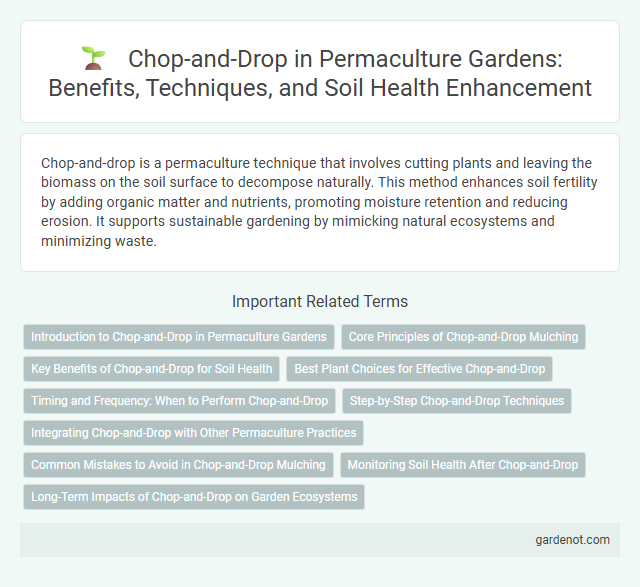Chop-and-drop is a permaculture technique that involves cutting plants and leaving the biomass on the soil surface to decompose naturally. This method enhances soil fertility by adding organic matter and nutrients, promoting moisture retention and reducing erosion. It supports sustainable gardening by mimicking natural ecosystems and minimizing waste.
Introduction to Chop-and-Drop in Permaculture Gardens
Chop-and-drop is a sustainable mulching technique widely used in permaculture gardens to enhance soil fertility and moisture retention. This method involves cutting down perennial plants or cover crops and dropping the biomass directly onto the soil surface, where it decomposes and enriches the soil with organic matter. Incorporating chop-and-drop practices promotes nutrient cycling, suppresses weeds, and supports beneficial soil microorganisms for healthier garden ecosystems.
Core Principles of Chop-and-Drop Mulching
Chop-and-drop mulching involves cutting plants and immediately placing the material on the soil surface to enhance nutrient cycling and soil fertility. This practice supports soil moisture retention, suppresses weed growth, and encourages beneficial microbial activity. By integrating organic matter directly into the soil ecosystem, chop-and-drop aligns with permaculture's regenerative principles for sustainable land management.
Key Benefits of Chop-and-Drop for Soil Health
Chop-and-drop significantly enhances soil health by providing a natural mulch that conserves moisture, reduces erosion, and suppresses weeds. Decomposing plant material enriches the soil with organic matter and nutrients, fostering beneficial microbial activity. This method promotes a sustainable nutrient cycle that improves soil structure and fertility without the need for synthetic inputs.
Best Plant Choices for Effective Chop-and-Drop
Leguminous plants like pigeon pea and cowpea are top choices for chop-and-drop due to their nitrogen-fixing abilities, enriching soil fertility naturally. Fast-growing species such as comfrey and comfrey varieties provide abundant biomass quickly, offering effective ground cover and mulch. Incorporating diverse shrubs and trees such as moringa and gliricidia maximizes nutrient cycling and supports long-term soil health in permaculture systems.
Timing and Frequency: When to Perform Chop-and-Drop
Chop-and-drop is most effective during the active growing season when plants have developed sufficient biomass but before they begin flowering or seeding, ensuring nutrient-rich mulch for the soil. Performing this practice every 4 to 8 weeks maintains consistent ground cover, suppresses weeds, and promotes healthy soil microbial activity. Timing chop-and-drop with plant growth cycles maximizes nutrient recycling and supports overall garden productivity.
Step-by-Step Chop-and-Drop Techniques
Chop-and-drop techniques involve strategically cutting plants and allowing the organic matter to decompose on-site, enriching soil fertility and moisture retention. Begin by selecting fast-growing, nutrient-rich plants like comfrey or legumes, then trim them close to the base without uprooting, ensuring root systems continue to nourish the soil. Spread the cuttings evenly around the base of desired plants to create a natural mulch that suppresses weeds and recycles nutrients effectively within the permaculture system.
Integrating Chop-and-Drop with Other Permaculture Practices
Integrating chop-and-drop with other permaculture practices enhances soil fertility by combining organic mulch application with crop rotation and companion planting, promoting nutrient cycling and pest control. This method supports dynamic accumulation of biomass, boosting microbial activity and moisture retention in the soil profile. Coordinated use with water harvesting systems optimizes resource efficiency and sustains long-term garden productivity.
Common Mistakes to Avoid in Chop-and-Drop Mulching
Chop-and-drop mulching often fails due to using fresh, nitrogen-rich green materials that cause nutrient imbalances and slow decomposition. Avoid piling thick layers that block airflow, leading to mold and root rot, and ensure a diverse mix of plant residues to maintain soil microbial activity. Neglecting to time the chop-and-drop process with plant growth cycles can reduce mulch effectiveness and disrupt surrounding vegetation health.
Monitoring Soil Health After Chop-and-Drop
Monitoring soil health after chop-and-drop involves regularly assessing key indicators such as soil moisture, nutrient levels, and microbial activity to ensure optimal decomposition and nutrient cycling. Implementing soil tests and observing earthworm populations help gauge improvements in soil structure and fertility. This practice supports sustainable permaculture by promoting organic matter retention and enhancing soil biodiversity.
Long-Term Impacts of Chop-and-Drop on Garden Ecosystems
Chop-and-drop enhances soil fertility by continuously supplying organic matter, which improves nutrient cycling and moisture retention in garden ecosystems. This method supports beneficial microbial activity and fosters a balanced soil structure, promoting plant health over time. Long-term application reduces reliance on external fertilizers and contributes to sustainable, self-maintaining permaculture systems.
Chop-and-drop Infographic

 gardenot.com
gardenot.com